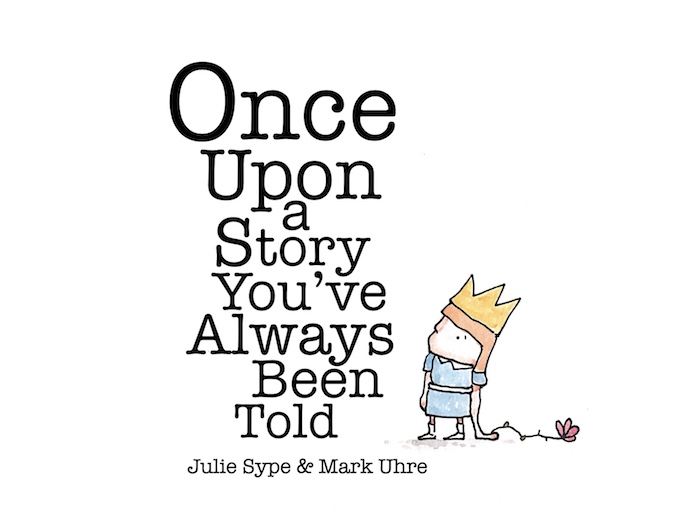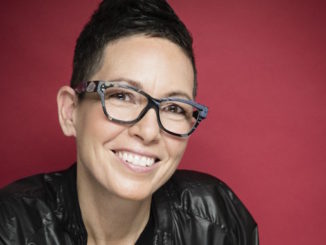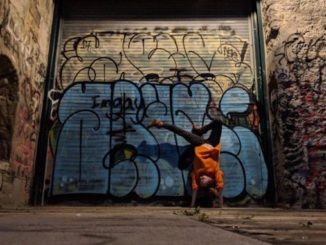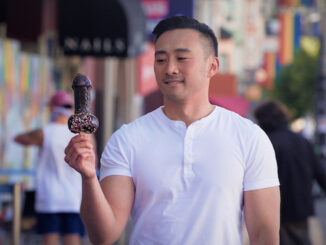Pride month is for everyone. During this month of celebration and raising awareness we also have the kids on our minds. Once Upon a Story You’ve Always Been Told is a sweet, yet powerful story recently published and it’s free on iBooks, but it’s a “Once upon a time…” type of fable that we didn’t grow up with. It’s the story of a courageous princess and redefines the classic fairy tale endings. This princess isn’t looking to be rescued by a handsome, strong prince — she’s listening to her heart and looking for freedom. Written by Toronto-based author Julie Sype and illustrated by Mark Uhre, we think this book is good for any time of the year.
We had a chance to speak with them about this wonderful story that celebrates inclusivity and self-acceptance. It’s already topping the Kids’ Book charts in multiple countries.

As girls, growing up we were always told that “Prince Charming” or “Mr. Right” will come along and save us. Now things have changed. Do you recall the first time you had realized that this is just in the story books?
Julie: I think I have a colossal arsenal of memories that absolutely would apply. I’m not sure if I have a first time memory because I feel like those revelations wound themselves into my consciousness at a regular cadence while I was growing up. Always revealing themselves at the most unpredictable times. I remember being 14 years old and hanging with a group of friends who decided to go camping for the first time together. We’d scrounged all this gear, supplies and food and we reeked of innocence and angst. Only the older boys had their drivers permits. When we parked at our campsite I was fully prepared to sit back and watch the boys assemble the tents and start the fire. I shudder admitting it, but at the time, it’s true. Then all of the sudden – the sky opened and it started to pour and watching the boys fumble with setting up the site wasn’t an option. It was unravelling at break neck speed. I had loads of experience camping as a little girl so I took control of the scene and put together everyone’s tent in the streaming rain. It’s the oddest memory to recall because at the time I felt a mix of empowered and disappointed. There was this cloud of embarrassment shrouding me. I remember apologizing to one of the boys later on for “showing him up” and him scowling back at me. It was definitely an upset to some idea we had of each other – and I suddenly wanted to make myself very small.
It wasn’t until later on that I realized I should never have hesitated to share my own experiences in an area I had expertise just because I identified as being the (youngest) girl. At the time, it was an attractive narrative to have someone sweep in and do everything for you. But it’s a dangerous story to tell yourself if you are later going to passively rename those actions in your mind as love. Especially if it limits the love you could claim for yourself.
I think that’s why my favourite page in the book is Mark’s illustration of the little princess in a mask flying fast on a skateboard with sleeping cookies for a dragon. Her escape from the tower is never reliant on the appearance of a shining prince. She knows how to get out of the tower – but she decides to think things through on her own and do the work on herself.
Mark: I am not female , but offer something on this subject anyway
I grew up in the 80s when children’s book writers and illustrators were finding a special place in libraries and books stores. The message of a girl not needing a “Prince Charming”, or MR. RIGHT, was already being told in powerful ways in children’s lit. But these messages were still being told from a heterosexual perspective. As a gay kid, I understood all of the messages (whether good or bad), but looking back, I wasn’t represented anywhere on a bookshelf.
When shopping around this story idea, what was some original feedback?
Julie: Well, for starters we both come from a performance background so we were total unknowns in the Children’s Literary World. Sharing in a new medium, is always difficult to navigate – Who do you send it to? How do you say?
“Hi, Please look… we wrote a story…?” It’s a totally surreal and vulnerable experience to try anything new. But the print publishers we spoke with back then were kind and also hesitant. I’m not totally sure if it was our lack of previous establishment in the genre that held them back or the subject matter. We were told that the story and art was very strong but that we should look at smaller print houses or “alternative” print houses. We both privately disagreed and decided that we should try to share this message of inclusivity and self acceptance from the largest, loudest and most accessible platform possible. We both wanted to create a book that didn’t exist for us when we were kids. And make it available now. And for free. We knew we didn’t want a dollar sign standing in front of this imperative conversation. So we found a way to offer it to everyone.
So, why did you decide to have it distributed through iBooks?
Julie: From our very first conversation with iBooks it was evident that our values matched. They were behind the message in the book immediately and the way we chose to distribute it was entirely up to us. They stand for diversity and inclusivity and are courageous in their platform. This time – there was no hesitation. I remember thinking – wait a minute… you will also support this message without a financial exchange attached to it?! Even if we choose to make it free because we believe that’s the most salient way to share this little princess’s story and empower others. That’s so extraordinary! Just think about the boundlessness available to story seekers and story tellers. There was zero added cost, immediate global access, and suddenly the barriers for people who wanted to participate in this narrative started to fade away. It made us feel like there was a conversation alive inside and outside of this book. That hearts and minds could align and rally for the inclusion of all stories.
What kind of freedom/flexibility did you experience publishing digitally vs traditional publishing?
Julie: Oh, I have yet to be traditionally published but I would imagine there are a quite a few differences. We had to take editorial responsibility ourselves. Which is a polarizing feat. Great in many ways and challenging in others. Mark had the final say on the layout of the visual and likewise I had control over the text. But we worked together through the entire process and we were creating a story that was not conventional and in one sense it was liberating to do that unconstrained by the limitations and customs of the way things have always been done.
Mark: With technology at the worlds finger tips, right away, iBooks felt like the right fit to bring our little book instantly into people’s hands. We were able to create and present our art together using a platform that would allow us to stay true to our message as artists while also making it FREE. iBooks is celebrating new stories and proactively filling a void in bringing important messages to readers of all ages, especially via their kids section.
What kind of responses are you getting now that the story is published?
Julie: The response has been enormously positive and strong. People are writing letters to us about their own experiences that are profound. Across Social Media the amount of people sharing the story is stunning. Hearts are aligning and this little princess’s message is ringing true for many people.
There is clearly an outstanding space available for more stories like these. We both believe it’s essential to include stories of diversity with children while they grow up. And the only effective way to eradicate shame in our culture is by inclusion.
Making the classroom a safe place for everyone is a modern mandate that needs the support of new stories, and this book can be a wonderful companion piece to that conversation. An imperative conversation about allowing everyone to be themselves.
This is one princess’s journey – but it’s our hope that this little princess’s story will continue to promote the space for other children to share their own.
Mark: The response has been positively overwhelming on all levels. The messages we have received through social media, iBook reviews and email has proved to us that this story was not only important for us to create as artists, but it is now being reached for on the Internet book shelf, available to curious readers.
We love the illustrations as well, how did you and Mark decide to collaborate?
Julie: It began as a request from Mark to me. He simply called me up once and said “I’d like you to write me a children’s book and all I care about is that the princess is a lesbian.”
I remember saying “Ok” and pretty much that was the end of the conversation. We have been best friends since we were very young, we met when we were 9 years old and since then there has been a crucial connectivity between us. I don’t want to say we can read each other’s minds but Mark would claim that. So once the text was written I sent it back to him and he started to illustrate. We had very little contact in the creative process until it was close to the end. Then we spoke multiple times a day. It’s kind of a whimsical situation because we lift each other up we don’t tend to disagree on many things. There is a lot of mutual respect and immense love so that makes the process a complete dream.
Mark: We have been supporting each others voices as artists ever since we were little kids. In some ways we have been collaborating already for years. Always talking art and bouncing ideas around on all forms and about many subjects. We have forever been on the same page in our celebration and appreciation of all forms of art and artists. Because of this alignment, when creating, we immediately jumped into a natural rhythm. When we decided to go on this adventure together we dove in and never looked back. It has been the most amazing and beautiful collaboration. I love Julie as a human…ever since we were little, but I am also madly in love with her artistry. To be inspired to create art with someone you already deeply love and respect….well….I don’t think there is a better formula for creation.
So, what is love? Or what does love mean to you?
Julie: Ok, “Love” is defined so interpersonally and it’s meaning is so deeply dependent on our independent values – that I can more easily define what love is not then what love is. It’s easy to see that love is not hate. Love is not persecution. Love is not segregation. Love is not jealousy or bigotry or sexism or fascism or racism or homophobia or xenophobia or anything that attempts to separate us from uniting as one heart.
Love is radically inclusive and empathetic and considerate of the entire human experience as a whole. It’s a force that lives within us all that allows us to see what unites us not what divides us. It’s a divine right to love and be loved and we should encourage everyone to explore the boundaries of their own heart. It’s only by pushing ourselves to the limits of what we can understand in one another, that we are drawn together as a whole.
Love is the only resource on the planet that is available in infinite supply and yet we are constantly trying to control it. Love is not control over another person.
In order to love each other and ourselves we must first be willing to allow everyone to be themselves. That’s the freedom we allude to through our little princess’s tale. That’s the love we hope to share.
Mark: Love is the celebration of all things good. Love is personal, unapologetic and unconditional. Love is active. Like art, it is inspired and created.




